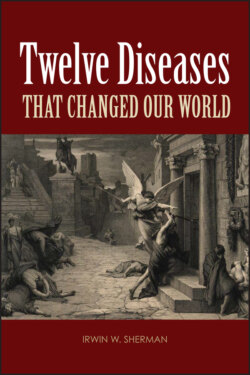Читать книгу Twelve Diseases that Changed Our World - Irwin W. Sherman - Страница 7
Gene failure
ОглавлениеPorphyria, a hereditary error of metabolism, is linked to the body's production of the pigment hemoglobin, which gives color to our red blood cells and grabs oxygen molecules as blood courses through the lungs. Hemoglobin consists of a protein, globin, coupled to a nonprotein molecule, heme. Heme, an iron complex within a ring structure called porphyrin, is synthesized in the red cells and liver. The reverse of this process, that is, the breakdown of heme to salvage the iron, results in the formation of bile pigments which are stored in the gallbladder and function as a detergent to emulsify fats for easier digestive action; bile pigments also color the feces brown. If there is a block anywhere in the eight-step pathway of heme formation, heme is not produced and the porphyrin intermediates accumulate in a variety of tissues in the body.
The pathway of heme manufacture can be thought of as if it were a river flowing downstream with a series of eight waterwheels along the way; each waterwheel is a cellular factory for making heme intermediates, i.e., porphyrins. To allow for control of water flow, a series of sluice gates are positioned ahead of each waterwheel. For a waterwheel to turn, each sluice gate must be opened by a gatekeeper. When a gatekeeper cannot open a gate, the flow of water is interrupted; water accumulates behind the waterwheel and spills over. Similarly, in the pathway for the synthesis of heme, the gatekeepers are the eight biological catalysts, called enzymes, that allow a controlled flow of intermediates in the pathway. If a gatekeeper “falls asleep at the wheel,” i.e., a particular enzyme does not function properly (or is absent), the normal pathway to heme is blocked and porphyrins accumulate in front of the block. These increased amounts of porphyrins do their dirty work, causing abdominal pain and neuropsychiatric symptoms (such as those seen in Mary and James), although the precise molecular basis for this is not known. The porphyrins in the skin, when exposed to UV light, become “excited” and in this state react with molecular oxygen to form activated oxygen, which can lead to cell death, with redness and blistering of the skin and scarring. The porphyrin intermediates also spill over into the urine during an attack. In an individual with porphyria, fresh urine is colorless, but on exposure to air and light for several hours it turns the color of port wine.
How did James I get porphyria from his mother, Queen Mary? The disease was transmitted through inheritance, not by contagion. Porphyria is transmitted as an autosomal dominant; that is, it is not carried on either the X or Y chromosome but on one of the other 44 chromosomes. The presence of a single copy of the defective gene has noticeable effects on the body. If one parent carries the defective gene, then, on average, half the children will bear the defective gene; this gene encodes a defective enzyme and causes porphyria. Most often the disease arises from a partial deficiency in a liver enzyme in the third step (or sometimes the seventh step) of heme synthesis. Porphyria is often more prevalent in females than in males, but in both sexes the symptoms rarely occur before puberty. These days, there are treatments for the disease symptoms, and dietary measures can reduce overproduction of porphyrins; however, in the time of Queen Mary and King James there was no such help.
